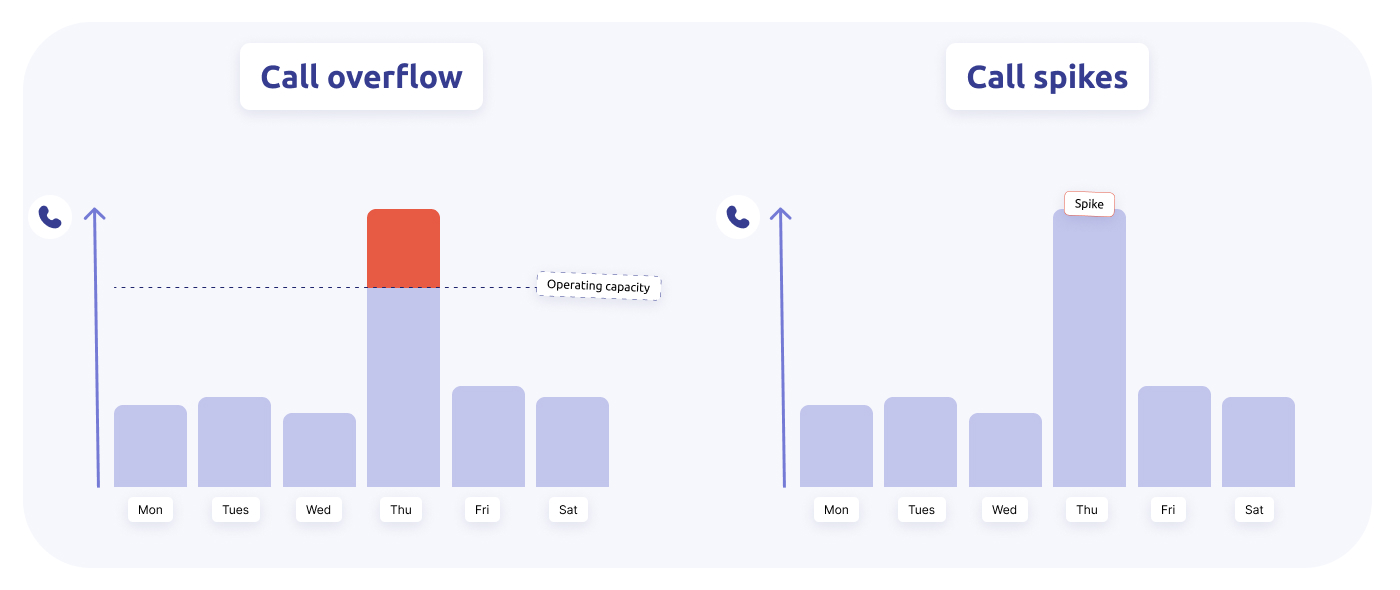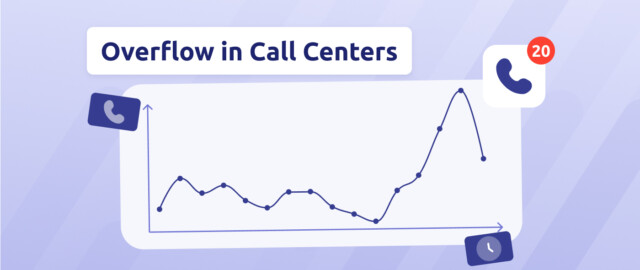What Is Overflow in a Call Center?
Overflow in call centers happens when the number of incoming calls exceeds the center’s ability to handle them. This can occur during a technical outage, or a sudden surge in customer demand. Without the proper response in place, the risk is clear: long wait times, missed calls, and an increased call abandonment rate.
To prevent overflow from harming service quality, contact centers need both proactive and reactive strategies. These may include rerouting calls to backup teams, outsourcing part of the volume, or activating an enhanced voicemail system.
Smart routing tools like ACD (Automatic Call Distribution) help distribute calls based on agent availability and skill sets. At the same time, automation plays a key role in absorbing part of the load—with intelligent IVRs, virtual agents, or self-service solutions filtering simple inquiries, guiding callers, and easing pressure on phone lines.
Overflow vs. Call Spikes: What’s the Difference?

The terms “call spike” and “call overflow” are often used interchangeably, but they refer to two different realities.
A call spike is a temporary increase in call volume, often expected. It might follow a new product launch, a seasonal event, or a promotional campaign. These events can usually be planned for, and teams adjust staffing accordingly to maintain a smooth service.
Overflow, on the other hand, occurs when the spike outpaces your handling capacity. It’s the consequence of a surge that wasn’t absorbed properly. Agents become overwhelmed, queues pile up, and calls are either lost or routed inefficiently.
How to Handle Overflow in Call Centers
Train Agents to Manage Call Overflow More Efficiently
A call center’s ability to maintain service levels during high call volume periods depends heavily on how well agents can adapt under pressure. Training is key.
It’s not just about managing stress—it’s about building the right habits. When overflow hits a call center, every second matters. Agents must know how to prioritize requests, use efficient call scripts, redirect to the right channels, and trigger pre-recorded messages to keep conversations moving.
Training should also include tools usage—call categorization, intent detection, and automated responses. The better agents know how to use these systems, the more efficient they become during high-demand periods.
Workforce Forecasting: Prepare for the Surge
Call overflows aren’t always a surprise. By analyzing past trends and identifying peak periods within your statistics, call centers can proactively adjust operations.
Forecasting allows you to align staffing levels with actual demand. With the right number of agents at the right time, you lower the risk of overflow, avoid long queues, reduce missed calls, and improve satisfaction on both sides of the line.
Offer Multiple Channels to Reduce Phone Line Pressure
When call volume spikes, offering alternative contact channels is a smart move. Live chat, email, and SMS can handle a portion of inquiries, reducing the strain on the voice channel.
This omnichannel approach helps prioritize urgent calls while guiding other customers to faster, more efficient digital channels. It prevents overflow and ensures a more consistent customer experience.
Automation also helps—automated responses or guided flows reduce the number of interactions that require human intervention. This frees up agents’ time for more complex issues and boosts overall responsiveness.
The Real Impact of Call Overflow
First Call Resolution Rates Drop
Overflow in a call center puts pressure on teams to work faster. As agents rush through calls, first call resolution (FCR) often suffers. Customers may need to call again, repeat themselves, or switch channels just to get an answer.
Over time, this weakens both customer satisfaction and the center’s efficiency. The more calls you handle, the harder it gets to manage volume, creating a cycle that’s tough to break.
Customer Experience Takes a Hit
Poorly managed overflow damages the customer experience. Long waits, unanswered calls, and rushed conversations give the impression that the business is overwhelmed—or worse, indifferent.
Frustrated customers may leave, or leave bad reviews. In both cases, the brand’s reputation takes a hit, and online visibility suffers as a result.
A Threat to Scalability
Recurring overflows are a sign that your operations have reached their limit. If your current setup can’t handle more calls, it won’t be able to support business growth either.
True scalability depends on lightening the operational load. A smart telephony solution helps by automating repetitive tasks, directing calls intelligently from the first second, and filtering simple inquiries. As a result, agents become more productive and can handle higher volumes without sacrificing quality.
How a Smart Telephony Solution Can Help with Overflow in Call Centers

Smarter IVR Systems
An optimized IVR (Interactive Voice Response) system filters calls in the first few seconds, routing customers to the right department or handling common inquiries automatically. That means fewer calls needing a live agent, freeing up resources for complex requests.
Benefits of ACD (Automatic Call Distribution)
ACD systems distribute incoming calls based on agent availability, skills, and call priority. This dynamic routing prevents bottlenecks, keeps workloads balanced, and ensures faster, more relevant responses.
Voicebots That Handle Volume
A voicebot can manage part of the inbound call flow without human intervention. These self-service tools understand voice commands, guide customers through a process, and provide clear answers—24/7.
During a call overflow, voicebots help reduce congestion by absorbing simple or repetitive requests and keeping queues under control.
Cloud-Based Flexibility for Agents
With a cloud telephony solution, agents can answer calls from anywhere. That means during high-volume events, you can quickly scale up your workforce by activating remote agents or teams in other locations. This flexibility helps you manage overflow in a call center without compromising service continuity or quality.
Conclusion
Call overflow isn’t just a temporary glitch—it’s often a symptom of deeper organizational issues that can damage customer relationships and hinder growth.
Some companies let it take a toll—agents burn out, resulting in a higher turnover, customers leave, and service quality drops. Others adapt. They plan ahead, diversify their channels, and empower their teams with smarter tools.
Improving how you forecast and manage overflow in call centers is critical to protecting your customer experience and building a scalable support operation. With the help of Diabolocom’s AI-powered telephony solution, contact centers can increase efficiency, handle more calls, and maintain high-quality service even under pressure.
Prevent overflows with Diabolocom



